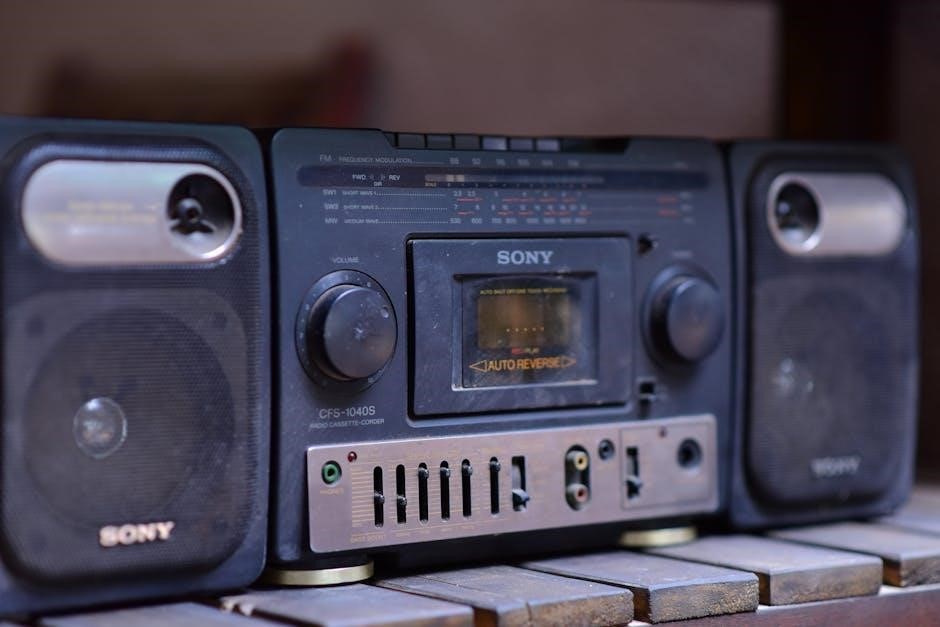A radio thermostat is a wireless, programmable device that controls heating and cooling systems, offering smart features like remote access and energy-saving capabilities through smartphone apps.
1.1 Overview of Radio Thermostats
A radio thermostat is a wireless, programmable device designed to control heating and cooling systems. It offers remote access, smart features, and compatibility with various HVAC systems. These thermostats provide advanced temperature management, programmable scheduling, and energy-saving capabilities. They often feature touchscreen interfaces and integration with smart home systems, allowing users to adjust settings conveniently via smartphone apps or voice commands.
1.2 Benefits of Using a Radio Thermostat
Radio thermostats offer enhanced convenience, energy efficiency, and smart home integration. They enable remote temperature control via smartphone apps, reducing manual adjustments. With programmable scheduling, users can optimize energy usage, lowering utility bills. Wireless connectivity eliminates wiring hassles, while compatibility with smart systems like Hubitat and Vera ensures seamless integration. These thermostats also provide real-time feedback, improving comfort and energy management.

Installation Guidelines
Installation involves preparing the site, labeling wires, and ensuring system compatibility. Follow safety guidelines and manufacturer instructions for a seamless setup experience.
2.1 Preparing the Site for Installation
Begin by removing the existing thermostat and labeling all wires. Ensure the area is clear and accessible. Rotate the thermostat cover to expose the battery compartment and wire terminals. Refer to the interactive PDF manual for specific instructions and safety precautions. Prepare tools and materials to ensure a smooth installation process.
2.2 Wiring Instructions for Radio Thermostats
Connect the wires to the corresponding terminals on the new thermostat, following the labeled connections from the old unit. Secure all wires tightly to prevent loose connections. Refer to the HVAC-specific wiring steps in the manual for compatibility with your system. Ensure proper installation to maintain functionality and safety, avoiding any cross-wiring that could damage the system.

Programming the Radio Thermostat
Program your thermostat by setting daily schedules, adjusting temperature settings, and enabling features like HOLD mode for manual control. Use the touchscreen or app for easy setup.
3.1 Setting Up Daily Schedules
Set daily schedules by touching the screen to select time and temperature. Program different settings for weekdays and weekends. Use the menu to customize start and end times for optimal energy use. Ensure the thermostat is in programming mode to save your preferences. Refer to the manual for step-by-step guidance on creating a tailored schedule that fits your lifestyle and energy-saving goals.
3.2 Using HOLD Mode for Manual Temperature Control
HOLD mode allows you to manually set a target temperature that remains until deactivated. Activate by selecting HOLD on the thermostat or via the app. This overrides scheduled settings, providing temporary control without altering your programmed schedule. Ideal for precise temperature adjustments, HOLD mode ensures comfort while maintaining energy efficiency until your regular schedule resumes automatically.

Key Features of Radio Thermostats
Radio thermostats offer remote smartphone app control and seamless integration with smart home systems like Hubitat and Vera, enhancing convenience and automation for users.
4.1 Remote Control via Smartphone Apps
Radio thermostats enable convenient remote control through dedicated smartphone apps, allowing users to adjust settings, monitor temperatures, and receive notifications from anywhere. Compatible with systems like Hubitat and Vera, these apps provide seamless integration, letting users manage their HVAC systems effortlessly. Features like HOLD mode and manual adjustments ensure precise control, enhancing comfort and energy efficiency while offering a user-friendly experience.
4.2 Smart Home Integration (e.g., Hubitat, Vera)
Radio thermostats seamlessly integrate with smart home systems like Hubitat and Vera, enabling advanced automation and control. These systems allow local control without cloud dependency, ensuring reliable operation. Compatibility with platforms like Vera enables synchronized temperature adjustments and fan state changes, providing a unified smart home experience. This integration enhances convenience, efficiency, and system management, making it ideal for modern smart home setups.
Maintenance and Troubleshooting
Maintain your radio thermostat by replacing batteries and checking wire connections regularly. Troubleshoot common issues like connectivity problems or temperature inaccuracies to ensure optimal performance and reliability.
5.1 Replacing Batteries and Checking Wire Connections
To ensure uninterrupted operation, replace batteries in your radio thermostat when the low-battery indicator appears. Carefully remove the cover, typically by rotating it toward the wall, and install new batteries. Additionally, inspect all wire connections for looseness or damage, ensuring they are securely fastened to avoid connectivity issues or incorrect temperature readings.
5.2 Resolving Common Issues
Common issues with radio thermostats include unresponsive screens or lost wireless connections. Restart the device by removing batteries or power cycling. Ensure the thermostat is properly paired with your HVAC system and that all wires are securely connected. For persistent problems, refer to the interactive PDF manual or manufacturer FAQs for troubleshooting steps and solutions to restore functionality effectively.

Advanced Settings and Customization
Radio thermostats offer advanced settings for customization, including sensitivity adjustments and temperature calibration, allowing users to fine-tune their system for optimal performance and energy efficiency.
6.1 Adjusting Sensitivity and Temperature Calibration
Adjusting sensitivity ensures accurate temperature readings, while calibration fine-tunes the thermostat’s response. These settings optimize system performance, reducing energy use and ensuring consistent comfort. Calibration involves verifying temperature accuracy and adjusting as needed to match your home’s conditions. Proper sensitivity ensures the thermostat reacts appropriately to temperature changes, enhancing overall efficiency and user satisfaction.
6.2 Enabling Fan and System Mode Settings
Enable fan modes to control airflow, optimizing comfort and energy use. System mode settings allow switching between heating, cooling, or auto modes. Adjust these settings to customize operation, ensuring efficient temperature management. Access these options via the thermostat interface or smartphone app, leveraging smart features for enhanced control and tailored comfort in your home environment.

Energy-Saving Tips
Optimize your radio thermostat by adjusting temperature settings and utilizing smart features like geofencing. Regularly update your system for enhanced energy efficiency and savings.
7.1 Optimizing Temperature Settings
Optimize your radio thermostat by setting temperatures based on daily schedules and occupancy. Lower temperatures when away or sleeping, and raise them when home. Use smart adjustments to balance energy savings and comfort. Regularly review and tweak settings to match seasonal changes and preferences, ensuring efficient heating and cooling throughout the year.
7.2 Using Smart Features to Reduce Energy Consumption
Utilize smart features like geofencing and smart sensors to optimize energy use. These technologies adjust temperatures based on your location and home occupancy, ensuring efficient heating and cooling. Additionally, energy reports provide insights into your consumption patterns, helping you make informed adjustments. By leveraging these intelligent tools, you can significantly reduce energy waste while maintaining comfort and convenience in your home.
Compatibility and System Requirements
Radio thermostats are compatible with various HVAC systems and smart home platforms like Hubitat and Vera, ensuring seamless integration and enhanced functionality for efficient temperature control.
8.1 HVAC System Compatibility
Radio thermostats are designed to work with a wide range of HVAC systems, including forced air, heat pumps, and dual fuel systems. They are compatible with most 24V heating and cooling systems, ensuring seamless integration without the need for additional adapters. This versatility makes them suitable for various home setups, providing efficient temperature control across different system types.
8.2 Checking Wireless Signal Strength
Ensuring strong wireless signal strength is crucial for reliable radio thermostat operation. Place the thermostat away from obstructions like walls or metal objects to maximize signal reach. Use the device’s built-in signal strength indicator or app to verify connectivity. A weak signal may cause intermittent control issues, so repositioning or resetting the device can help restore stable communication with your HVAC system.

User Manuals and Resources
Access interactive PDF manuals for detailed instructions and troubleshooting guides. Find additional resources, FAQs, and user guides to optimize your radio thermostat’s performance and functionality.
9.1 Accessing Interactive PDF Manuals
Interactive PDF manuals for radio thermostats are designed for easy navigation on computers. Clickable buttons and hyperlinks guide users through installation, programming, and troubleshooting. These manuals are available for download from official websites or product pages, ensuring quick access to detailed instructions and visual aids. They are compatible with Adobe Acrobat Reader and similar software, making them universally accessible for users.
9.2 Finding Additional Guides and FAQs
Additional guides and FAQs for radio thermostats provide comprehensive support beyond the manual. These resources cover troubleshooting, advanced features, and compatibility with smart home systems. Users can find detailed FAQs on product pages or manufacturer websites, addressing common issues and offering step-by-step solutions. Spare parts lists and multi-language manuals, including French, English, and German versions, are also available for enhanced convenience and understanding.
Radio thermostats offer key features like smart home integration and energy efficiency. Final tips: Refer to your manual and additional guides for optimal performance and troubleshooting.
10.1 Summary of Key Features and Benefits
Radio thermostats offer wireless control via smartphone apps, smart home integration, and energy-saving features. They provide touch-screen interfaces, scheduling, and remote access, enhancing convenience and efficiency. Compatible with systems like Hubitat and Vera, they allow manual control with HOLD mode and optimize energy use through smart features. These thermostats combine modern technology with user-friendly design for seamless temperature management and reduced energy consumption.
10;2 Final Tips for Effective Use
Regularly update your radio thermostat’s software and check wire connections for optimal performance. Use HOLD mode sparingly to avoid energy waste. Schedule routine maintenance and battery replacements to ensure reliability. Explore advanced settings like temperature calibration for better accuracy. Utilize smart features and remote access to maximize convenience and energy efficiency. Always refer to the manual for troubleshooting common issues promptly.